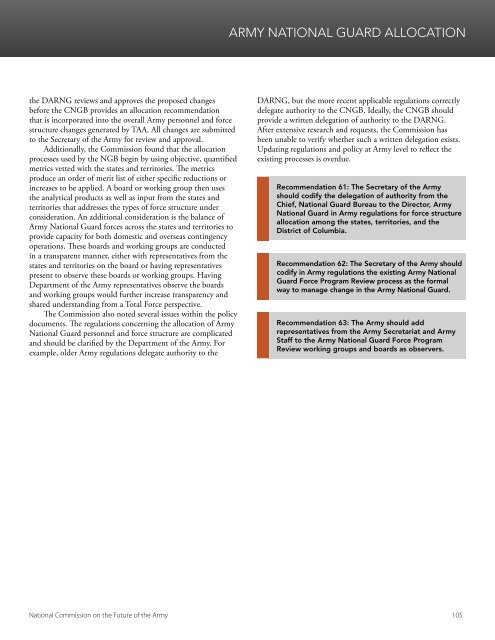THE FUTURE OF THE ARMY
NCFA_Full%20Final%20Report_0
NCFA_Full%20Final%20Report_0
Create successful ePaper yourself
Turn your PDF publications into a flip-book with our unique Google optimized e-Paper software.
<strong>ARMY</strong> NATIONAL GUARD ALLOCATION<br />
the DARNG reviews and approves the proposed changes<br />
before the CNGB provides an allocation recommendation<br />
that is incorporated into the overall Army personnel and force<br />
structure changes generated by TAA. All changes are submitted<br />
to the Secretary of the Army for review and approval.<br />
Additionally, the Commission found that the allocation<br />
processes used by the NGB begin by using objective, quantified<br />
metrics vetted with the states and territories. The metrics<br />
produce an order of merit list of either specific reductions or<br />
increases to be applied. A board or working group then uses<br />
the analytical products as well as input from the states and<br />
territories that addresses the types of force structure under<br />
consideration. An additional consideration is the balance of<br />
Army National Guard forces across the states and territories to<br />
provide capacity for both domestic and overseas contingency<br />
operations. These boards and working groups are conducted<br />
in a transparent manner, either with representatives from the<br />
states and territories on the board or having representatives<br />
present to observe these boards or working groups. Having<br />
Department of the Army representatives observe the boards<br />
and working groups would further increase transparency and<br />
shared understanding from a Total Force perspective.<br />
The Commission also noted several issues within the policy<br />
documents. The regulations concerning the allocation of Army<br />
National Guard personnel and force structure are complicated<br />
and should be clarified by the Department of the Army. For<br />
example, older Army regulations delegate authority to the<br />
DARNG, but the more recent applicable regulations correctly<br />
delegate authority to the CNGB. Ideally, the CNGB should<br />
provide a written delegation of authority to the DARNG.<br />
After extensive research and requests, the Commission has<br />
been unable to verify whether such a written delegation exists.<br />
Updating regulations and policy at Army level to reflect the<br />
existing processes is overdue.<br />
Recommendation 61: The Secretary of the Army<br />
should codify the delegation of authority from the<br />
Chief, National Guard Bureau to the Director, Army<br />
National Guard in Army regulations for force structure<br />
allocation among the states, territories, and the<br />
District of Columbia.<br />
Recommendation 62: The Secretary of the Army should<br />
codify in Army regulations the existing Army National<br />
Guard Force Program Review process as the formal<br />
way to manage change in the Army National Guard.<br />
Recommendation 63: The Army should add<br />
representatives from the Army Secretariat and Army<br />
Staff to the Army National Guard Force Program<br />
Review working groups and boards as observers.<br />
National Commission on the Future of the Army 105


